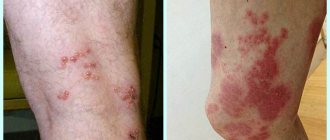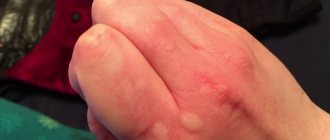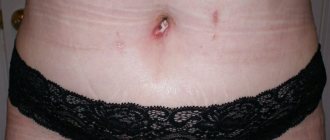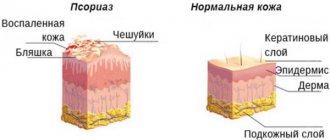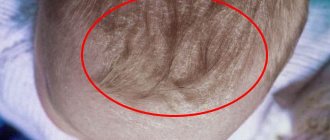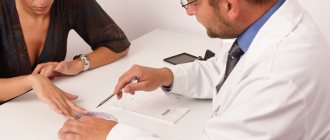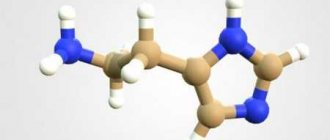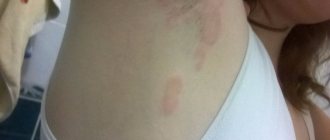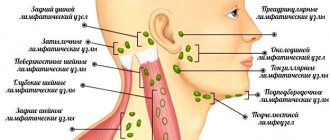The appearance of specific rashes on the buttocks is considered a sign of infection with herpes simplex virus type 1 or 2. The infectious agent penetrates through microtraumas on the skin, gaining a foothold in the epithelium. In a normal state of immunity, the virus is destroyed by antibodies, in other cases the affected cell is destroyed, and viral particles penetrate into the blood. Rashes do not appear immediately; the causative agent of infection is present in the nerve fibers in an inactive state for a long time.
The appearance of specific rashes on the buttocks is considered a sign of infection with herpes simplex virus type 1 or 2.
Herpes: general description of pathology
Actually, the Herpesviridae family includes several types of herpes viruses.
The most common types are type 1 and type 2, which cause the rashes known to many.
The varicella zoster virus (VZV type 3 or Varicella Zoster Virus) also belongs to this family.
Skin manifestations in humans are usually caused by herpes simplex viruses types 1 and 2 (HSV 1 and HSV 2).
Very rarely, the rash occurs due to reactivation of VZV type 3.
Rash on the buttocks is possible in two cases:
- HSV 1 or HSV 2 entered the human body through the genitals, that is, through sexual transmission. Then the pathogens remain forever in the neurons of the lumbar spinal cord, from where they periodically exit back to the skin.
- Herpes viruses type 1, 2 or 3 are completely out of control of the immune system, in such cases the rashes are massive, numerous and protracted.
Usually, herpes on the buttocks occurs in parallel with damage to the genital organs.
For most people, the first active episode develops 2-14 days after infection.
The more massive the infection, the shorter the incubation period.
Prevention of herpes
Prevention of the disease involves strict adherence to the rules of personal hygiene: using only personal household items, dishes, clothing, and regular hand washing with soap. The use of barrier methods of contraception is no less important, since one of the most common routes of infection with herpes virus type 2 is sexual. If there is a virus in the body, it is necessary to follow preventive measures that reduce the risk of recurrence of skin manifestations of the disease:
- to refuse from bad habits;
- eat well and rationally, if necessary, take vitamin and mineral complexes;
- play sports, lead an active lifestyle;
- maintain a sleep schedule;
- do not overcool or overheat;
- treat any diseases in a timely manner;
- avoid stress and overwork;
- do not take antibiotics, cytostatic and glucocorticoid drugs unless necessary.
To avoid infecting a child with herpes in utero, you should prepare for pregnancy: undergo an examination, and if the virus is present in the body, take a course of measures to prevent infection of the fetus.
There can be many reasons for acne on the tailbone, herpes is just one of them. Any change in the skin requires attention and medical examination; only timely diagnosis can reduce the risks of developing all kinds of complications.
Spread of herpes
Routes of infection depend on age.
Thus, children usually become infected from contact with sick adults or when using a sick towel.
In adults, herpes appears after unprotected sex or kissing.
The mechanism of autoinoculation has also been proven.
This is when herpes viruses in one person move from the face to the genital area and vice versa.
So a cold on the lips may well be combined with herpes of the buttocks.
What it looks like and where it is located
Herpes between the buttocks appears in the anus and rectum. In the first case, the virus affects the mucous membrane and folds of skin near the anus. Watery blisters are located in the anus. In women, perianal herpes can spread to the vagina.
Herpetic proctitis cannot be seen, since the rashes and ulcers are localized inside the rectum. However, a person will be bothered by itching and pain in the butt, which can spread to the hips and radiate to the lower back. Fever, chills, weakness, even nausea are possible. If gluteal herpes has spread to the vagina, the woman will experience heavy discharge.
Viral infections in the anus and buttocks are not always caused by HSV type 2. Herpes affects the mucous membranes of the perianal area as a result of unprotected oral sex if one of the partners has a relapse of the disease. During an exacerbation, the virus is active and can easily enter the body through microtraumas of the skin.
The appearance on the buttocks leads to negative consequences, for example, to the occurrence of various complications and the appearance of concomitant diseases.
Treatment of herpes on the buttock takes a comprehensive approach. It is necessary to weaken the influence of the pathogen on health and achieve stable remission. The sooner measures are taken, the faster a person will feel significant improvement, so it is important to know how the disease appears, develops and progresses.
Herpes: provoking factors
Despite the huge number of people infected, not everyone gets a rash.
The main reason for recurrence of herpes infection is weakening of the immune system, temporary or permanent.
The following factors can cause a subsidence of the body’s defenses:
- poor nutrition with vitamin deficiencies
- Unhealthy Lifestyle
- hypothermia or overheating
- severe chronic diseases - diabetes mellitus, thyroid dysfunction
- serious bacterial infections, such as lobar pneumonia
- chronic stress
- acquired immunodeficiency syndrome (HIV infection/AIDS)
All of the above conditions can cause another exacerbation of the infection.
Prevention measures
The main preventive measure is hardening, that is, strengthening the body's immune system. To do this, it is necessary not only to properly douse yourself with cold water, but also to diversify your daily diet with a sufficient amount of fresh vegetables and fruits.
Promiscuity should be avoided. During sexual intercourse, contraception must be used. It is also necessary to observe basic rules of personal hygiene.
Doctors also prescribe preventive medications. Their correct use allows people prone to herpesvirus infection to prevent the disease. The drugs of the nucleoside group help best in the fight, where Acyclovir is the most effective.
Symptoms of herpes on the buttocks
Rashes on the buttocks almost always indicate a fairly severe course of herpes.
Therefore, along with local symptoms, general symptoms are often noted.
Local symptoms:
- discomfort, burning and pain limited to a specific area of the buttock, while the skin is calm
- after 12-24 hours, blisters appear at the site of pain
- blisters are small, grouped in several pieces
- filled with a clear liquid that quickly becomes cloudy
- within a day or two, the blisters burst, leaving behind small erosions or ulcers
- in 2-3 days they become covered with crusts and dry out
The crusts fall off within 5-7 days, revealing pale, clean skin underneath.
Throughout the attack, the rash is disturbing - the person experiences a burning sensation and pain.
Given the location, it becomes painful to sit.
In addition, due to the movements of the buttocks when walking or when a person sits down, the crusts crack and peel off early.
This causes even more pain and delays recovery.
General symptoms are characteristic of the primary process, which develops at the end of the incubation period:
- weakness, dizziness
- increase in body temperature to 39-40˚C
- headache
- poor appetite
- aches minor body aches
With repeated attacks, general symptoms are usually absent.
The localization of the rash is of particular importance.
If they are concentrated in a cluster, closer to the perineum, then this indicates a fairly typical version of the infection caused by HSV type 1 or 2.
But when the rash looks like a stripe, a broken line, is localized on the lower back, in the upper or middle part of the buttocks, and is terribly painful, then these are signs of a type 3 herpes attack.
The same herpes zoster, zoster.
Symptoms
Herpes on the tailbone occurs in several stages, each of which has its own symptoms:
- Prodromal period. At this stage, signs of intoxication of the body appear: fever, headache, general weakness, aches in muscles and joints. The clinical picture of herpes at this time is similar to the manifestations of influenza and colds.
- Initial stage. A few days after the onset of general symptoms, specific ones appear. The skin in areas of future rashes swells and turns red, tingling, itching and burning are felt. If treatment is started during this period, rashes in the genital and buttock areas may not develop.
- Stage of vesicle formation. Herpetic rashes look like small blisters filled with transparent contents. The rash can occur between the buttocks, thighs, perineum, and genitals. Elements often merge, forming continuous lesions. The appearance of rashes is accompanied by severe pain.
- Healing stage. After a week, the vesicles open and weeping ulcers form. If hygiene rules are not followed, a secondary infection occurs, accompanied by suppuration of the affected areas of the skin. In the classic course of herpes, the ulcers are covered with dense crusts, which disappear after 10-14 days. Healing is not accompanied by tissue scarring.
The stage of vesicle formation in which herpetic rashes look like small bubbles filled with transparent contents.
Special and atypical variants of herpes on the buttocks
The typical clinical course may vary depending on a number of conditions.
Let's consider the features of HIV, pregnant women and pediatric patients.
All patients from these categories have a high risk of developing atypical forms.
Then the rash on the buttocks acquires features that are not characteristic of herpes:
- erythematous (hyperemia)
- bullous with blisters
- edematous without vesicles
- ulcerative-necrotic
In total, more than 10 atypical forms are known; it is very difficult for an inexperienced eye to recognize herpes in them visually.
Due to the loose fatty tissue, which is quite developed on the buttocks, especially in children and older women, the edematous form is more common in this area of the body.
Possible complications
Once a herpes infection enters the body, it remains with the patient forever, so herpes cannot be completely cured. The main thing is to learn to control the virus so as not to provoke a violent manifestation on the buttocks after infection with reduced immunity. If this happens, patients may experience complications. Among them are:
- damage to the central nervous system;
- ophthalmoherpes;
- miscarriage if the woman was ill during pregnancy;
- systemic herpes.
Herpetic infection on the buttocks affects both adults and children. The pathogen predominantly enters the body in childhood. The course of the disease depends on the state of the immune system, since the defenses can suppress the development of infection, and it occurs in a mild form. For a speedy recovery, it is recommended to start therapy at an early stage, using an antiviral and immunomodulatory agent.
Herpes with HIV
With HIV infection, the immune system suffers greatly, which is why herpes zoster-type rashes often occur.
Therefore, all such patients must be examined for HIV infection.
In addition, attacks are becoming more frequent; the buttocks are almost constantly covered with herpes blisters and crusts.
This option, along with a weakened immune system, creates favorable conditions for the addition of secondary pyogenic flora.
Redness, swelling, pain and purulent discharge appear.
Partly because of this, with a combination of HIV and buttock manifestations of herpes, the inguinal lymph nodes are often enlarged and the lymphatic vessels become inflamed.
Lymphostasis develops, the leg swells on one or both sides.
Treatment with traditional methods
It has already been mentioned that it is impossible to cure the disease forever; herpes may reappear on any part of the body at any time. The main tasks are to relieve unpleasant symptoms and reduce the number of relapses. If therapy is not carried out, the disease will return again. If the outcome is positive, remission lasts until the end of life.
To cure herpes, the patient must be prescribed a course of antiviral drugs. The best results are achieved by such drugs as Acyclovir and Inosine Pranobex. The action of the medications is aimed at destroying infected cells and improving immunity. The first positive effect is noticeable after 2-3 days of use. There are ointments and creams for quick treatment: Zovirax, Fenistil or Acyclovir. They should be applied to sore spots several times a day until the rash goes away completely.
Antihistamines will help relieve severe itching: Claritin, Desloratadine, Suprastin. Zinc ointment and Levomekol are prescribed to reduce pain, as well as treat an associated infection. In addition, painkillers can be prescribed - these are Ibuprofen, Ketoprofen, Nurofen. It is imperative to take vitamin complexes to help the body cope with a viral infection. You should continue taking it after recovery, especially in spring and autumn.
How to get rid of persistent herpes? In some cases (for example, if the disease often occurs in an elderly person), vaccination is suggested. Its goal is to reduce the activity of viral infection and increase the body's defenses. This is done only during remission; the acute phase is not suitable for vaccination.
Therapy with tablets and ointments is delayed for 7–14 days, depending on the severity of the disease. It is not advisable to take any medications on your own, because they all have contraindications and side effects. How to treat, dosage and duration are selected by the doctor individually for each patient, based on age, weight and stage of the disease.
Pregnancy and herpes
Pregnancy is a condition in which the immune system also weakens slightly.
Therefore, approximately 15-20% of women experience an exacerbation of herpes, possibly localized on the buttocks.
Active viremia during an attack causes problems with the placenta and has a toxic effect on the fetus.
Therefore, a painful rash on the buttocks of a pregnant woman is a reason to consult a doctor and check the condition of the fetus.
Children's age and herpes
Children can become infected with herpes in utero.
The second most important way is to visit children's groups; in kindergarten, a child can dry himself with someone else's towel.
And they also have several important points:
- lack of own immunity - everyone who is bottle-fed is at risk for the disease
- the age of crossover of the leukocyte formula is approximately 5 days and at 5 years the activity of cellular immunity in children greatly sags, and this is a significant danger of the appearance of herpes on the buttocks
- more pronounced general symptoms - fever, weakness, nausea and vomiting, loose stools
In a state of suppressed immunity, a child's buttocks can sometimes be attacked by a virus like zoster.
But only if he had previously had chickenpox or suffered from it in an erased form.
Sometimes parents confuse herpes on the child’s buttocks with prickly heat or diathesis.
Little children cry and cannot say that the pimples on their butts are itchy or painful.
Therefore, it is better to show all children with a rash on the bottom to a doctor.
Reasons for appearance
Herpes on the butt appears as a result of activation of the herpes virus against the background of decreased immunity. The disease often occurs after a cold, before menstruation in women, and during pregnancy. Infection occurs:
- Sexually. The risk group includes people leading a chaotic intimate life.
- In contact with infected people. The virus enters the body in the presence of wounds, abrasions and cracks in the skin and mucous membranes.
- Contact-household way. Infection occurs when using shared utensils, hygiene items, and towels.
Infection occurs through sexual contact. The risk group includes people leading a chaotic intimate life.
Complications of herpes on the buttocks
Ignoring herpes on the buttocks almost always leads to the development of serious complications:
- development of scarring in areas of repeated rashes
- weakened immune system
- chronic lymphadenitis and lymphangitis - a feature of the process in the groin is the risk of developing lymphostasis and elephantiasis on one or both legs
- diseases of the thyroid gland (thyroiditis) - active replication of the herpes virus can provoke the synthesis of antibodies to thyroid cells with the development of severe hypothyroidism
Blisters between the buttocks
The presence of a rash may be the main cause of blisters between the buttocks. This part of the body is prone to developing blistering rashes. Reasons include:
- Infections such as impetigo, staph bacteria, herpes, chicken pox and others
- Skin diseases such as dermatitis, epidermolysis
- Medications
- Allergies
- Intense friction of the skin between the buttocks
- Skin irritation.
Blisters between the buttocks can be painful depending on what is causing them. The duration of the rash depends on the underlying causes. While they can sometimes go away on their own within a few days, blisters caused by infection can remain for weeks or months.
Chronic problems may require long-term treatment to get rid of them (for example, the herpes simplex virus).
The skin in the buttock area is susceptible to infections, which may be difficult to notice. An infection of the hair follicles (folliculitis) usually goes away on its own without treatment. But it can also spread, causing boils that will require antibiotics.
Often the problem concerns people who are bedridden. The sores can become quite severe, resulting in ulceration and a large area of affected skin on the buttocks. A number of reasons that can lead to buttock ulcers include:
- Skin diseases, including various rashes
- Genital herpes
- Impetigo
- Allergic reactions
- Eczema
- Shingles
- Infections.
Diagnosis of herpes
Fortunately, most cases of herpes progress favorably, with relapses occurring no more than once or twice a year.
If the rash occurs more often, it makes sense to consult a dermatologist to clarify the diagnosis, further examination and prescribe treatment.
An experienced doctor can visually determine the fact of herpes.
Also for this purpose it is enough to mention that the rash on the buttocks occurs periodically and hurts.
Clinical protocols require the following studies:
- general blood and urine tests - general condition of the body
- determination by ELISA of antibodies to HSV types 1 and 2 or VZV type 3 in the blood - identification of the pathogen
- establishing the antibody avidity index - duration of infection
- scrapings and prints from rashes on the buttocks are used to perform a polymerase chain reaction (PCR) - accurate identification of the pathogen
- determination of antibodies to HIV
In addition to establishing the fact of infection, it is necessary to understand the causes of relapses.
The first step in this direction is screening for HIV infection, in which herpes breaks out very often.
Modern therapy
To prevent the progression of the disease and prevent transmission of the virus to other people, at the first symptoms, you must seek medical help. The therapeutic approach is necessarily comprehensive; it includes methods of dealing with uncomfortable and painful sensations.
The patient must be prepared for the fact that if he has been diagnosed with herpes of any form at least once, it will not be possible to completely cure the disease. It remains in the body forever; you can only stop its vital activity.
Medicines for treatment, their dose and regimen are determined by the attending physician. Basically the list is:
- Ointments for external use to eliminate visible manifestations of the disease.
- Medicines that kill viral cells.
- Products that strengthen the immune system.
- Multivitamin complexes.
It is worth noting that genital herpes, photos of the manifestations of which are presented at the very beginning of the article, can be treated fairly quickly with available medications.
Immunity indicators for herpes on the buttocks
An immunogram helps to get a complete picture of the characteristics of immunity.
To conduct such a study, the dermatologist engages an immunologist, who is responsible for deciphering the analysis.
An immunogram allows you to evaluate the most important indicators of cellular and humoral immunity:
- number of active lymphocytes and their ratio (CD3+ CD4+, CD3+ CD8+, CD3- CD16/56+, CD19+ cells)
- concentration of the main classes of antibodies in the blood (IgG, IgA, IgM)
- functional activity of macrophages
Clinical observations show that exacerbation of herpes infection is accompanied by a decrease in the number of CD4 cells.
At the same time, the functional activity of neutrophils decreases.
For a sick person, an immunogram study helps to more accurately determine the severity of the process.
Gives the most accurate forecast regarding the further course of the process.
Periodic conduct of such analysis during the remission stage allows timely identification of the threat of exacerbation and a course of preventive therapy.
Reasons for formation↑
The main reason for the appearance of herpes, according to immunologists, is a decrease in immunity, a regular or short-term decrease in the body’s protective activity. Having a strong immune system helps contain the virus and suppress its activity. There are several factors that contribute to the appearance of signs of infection:
- Lifestyle changes;
- Excessive emotional, mental and physical stress;
- Recurrence of the virus in other places on the body;
- Taking medications that weaken the immune system.
Treatment of herpes on the buttocks
No one has yet been able to completely cleanse the body of the herpes virus.
And it is unlikely that this will be done in the next few decades.
The main goal of herpes treatment is to prolong remission as much as possible and reduce the duration of exacerbation.
For people with buttock rashes, this means maintaining quality of life.
Most cases can be managed on an outpatient basis.
But you need to keep in mind that the buttocks are not the most typical surface for herpes.
Therefore, if a generalized form of infection or its atypical course is detected, hospital treatment may be required.
Medications play a key role.
Based on their mechanism of action, they are divided into three groups:
- Agents with direct antiviral activity. All such drugs have a similar mechanism of action - they disrupt the functioning of enzymes, due to which herpes viruses synthesize new copies of themselves.
- Interferons and immunoglobulins. They have a stimulating effect on the immune system (interferons) or saturate human tissues with ready-made antibodies to herpes, and through this mechanism they help cope with the infection.
- Vaccines. They help activate the immune system and correct its tension in the direction of herpes viruses.
The first ones are used during the period of rashes.
The latter help the former and reduce the activity of viruses.
And vaccination increases the body’s resistance to the corresponding type of herpes to the maximum.
ethnoscience
Important! Treatment with folk remedies should not be the basis of therapy. Always consult a specialist!
There are several recipes that can help cure herpes:
- Camphor oil - you need to lubricate each bubble separately, 3-4 times a day;
- Ice - when the rash has not yet appeared, you can apply ice wrapped in a napkin to the itchy area;
- Propolis tincture - soak a cotton swab in the infusion and wipe the skin (will help remove burning and pain);
- Toothpaste is one of the favorite folk recipes - you need to smear the affected skin with the paste at night, it will help dry out the inflammation;
- Lemon balm decoction - moisten a cotton pad and wipe the rashes; it perfectly soothes the skin.
Treatment of exacerbation of herpes
The most critical period.
Since herpes hurts in the acute phase, it is painful for the patient (if the rash is localized on the buttocks) to sit and walk.
Family members and loved ones are at risk of becoming infected if this has not happened before.
An attack can be quickly stopped only by a combination of two methods - local and general.
It is imperative to take into account immunodeficiency as a cause of exacerbation, since this has its own characteristics in terms of treatment (connection of immune drugs).
Infection
You can become infected with herpes only from a human carrier, and for this he does not necessarily have to show symptoms of the disease. This is due to the fact that the virus can be in the body both in an active form (i.e., multiply and manifest symptoms) and in a latent form, i.e. hidden (in this case there will be no signs of infection).
The microorganism can be transmitted through:
- saliva (for example, when kissing);
- blood (cuts, unsterile syringes, etc.);
- sputum, discharge from the lungs, saliva, etc. (anaerobic) - when kissing, during conversation.
Local therapy for herpes on the buttocks
Prescribed for all forms of herpes.
It consists of applying special ointments to the affected areas of the buttocks, which include antiviral drugs.
Local anesthetic, softening and stimulating additives are used as auxiliary components.
In principle, the same ointments that are used to localize the rash on the lips and other parts of the body are suitable for local treatment of herpes on the buttocks:
- Acyclovir ointment 5% on the affected area of the buttock from the appearance of the first symptoms (even with still healthy skin) 4-6 times a day until the crusts completely fall off
- gel with recombinant interferon alpha-2b 3-5 times a day until pain and erosion disappear
- Allomedin gel up to three times a day for 5-7 days
- zinc-based ointments - drying effect is important for extensive lesions, herpes rashes between the buttocks
- any ointments and creams with local anesthetics (anesthesin, lidocaine)
- antiseptics – brilliant green, fukortsin
- pain-relieving ointments and gels – kamistad, lidochlor, fastin-1
It is allowed to use alternative drugs to acyclovir - penciclovir (Fenistil-Pentsivir).
Iodine cannot be used.
Through the use of balanced and adequate local therapy, the duration of the acute phase of infection can be significantly reduced.
This means that a person is more likely to be able to sit down, walk and ride a bike calmly.
It also serves as an excellent prevention of infection to others.
Unfortunately, many patients prefer to limit themselves to local treatment.
And this is a big mistake, since no ointment or cream helps prevent the next attack.
Causes
Immunologists call the main factor of relapse a decrease in immunity, a permanent or temporary weakening of the body's protective functions. With strong immunity, the virus is contained by natural defenses and does not show activity. Also read - causes of herpes in humans.
The following are the causes of herpes on the buttocks :
Important! To treat herpes, our readers successfully use Elena Makarenko’s method. Read more >>>
- Physical fatigue.
- Stress, neurosis, psycho-emotional fatigue.
- Bad habits: smoking and excessive consumption of alcoholic beverages.
- Abuse of tonic drinks, such as coffee.
- Various types of poisoning of the patient's body.
- Colds.
- Chronic diseases that have a stable negative effect on the body's immune forces (diabetes mellitus).
- Menstruation.
- Overheating or hypothermia.
- Unbalanced diet and non-compliance with diet.
- Chronic lack of sleep.
The main methods of treating herpes in the buttocks area
Treatment of herpes on the buttock includes a whole range of therapeutic and preventive measures aimed at eliminating the symptoms of the disease, restoring the patient’s body and strengthening the immune system.
It is strictly selected by a medical specialist and carried out with constant supervision and control. Since it is impossible to cure herpes, the doctor’s main task is to prescribe a treatment that would increase the intervals between relapses and reduce their number to a minimum.
Trying to cope with the disease on your own is not recommended, since most often the treatment regimen is prescribed and selected individually, depending on the characteristics of the body, the cause of the disease and other factors. Only a specialist can choose how to treat herpes on the buttocks, focusing on the shape and severity.
The most positive effect occurs when prescribing complex therapy, which includes the following steps:
1) Drug treatment. It is carried out during the acute stage of the disease. Its duration is about a week.
- Standard therapy with antiherpetic drugs (Zovirax, Valtrex) is used.
- It is necessary to use ointments containing acyclovir or valocyclovir to reduce external symptoms.
- The use of antiviral and immunostimulating agents containing interferon.
- Taking vitamins and minerals to strengthen the body. Particular attention should be paid to vitamin complexes with a high content of vitamins C and E.
- If a lot of exudative fluid is released from the vesicles, doctors prescribe drugs to reduce its amount, for example indomethacin. Various antihistamines (loratadine, Erius) will help get rid of itching and swelling.
2) After external manifestations have been eliminated from the skin, immunostimulants and immunomodulators continue to be taken for a week.
3) At the third stage, patients are offered a special antiherpetic vaccine, which significantly reduces the number and duration of relapses. It has a positive effect on the activation of the immune system.
4) The last stage of treatment is clinical observation with periodic monitoring of the body’s condition using laboratory tests.
In addition, it is necessary to normalize the diet (increase the amount of protein foods consumed, give up junk food - fatty and sweet), pay special attention to the rules of personal hygiene, refuse to wear tight clothes that cause discomfort and use an individual towel.
How to protect yourself from herpes on the buttocks
In order to avoid infection with herpes or reduce the number of activations of the virus if it is already in the body, you need to follow a few simple rules:
- Maintain personal hygiene. Be sure to wash your hands several times a day, after being in public places and before eating.
- Do not ignore changes in the body and consult a doctor promptly
- Prevent diseases by taking acyclovir during the autumn and spring seasons of exacerbation of the disease (only after prior consultation with a doctor).
In addition to compliance with all treatment standards, it is necessary to pay special attention to the work and rest regime for the full recovery of the body. It is necessary to give preference to underwear made from natural fabrics and take a responsible approach to methods of protection and contraception during sexual intercourse.
Who said that curing herpes is difficult?
- Do you suffer from itching and burning in the areas of the rash?
- The sight of blisters does not at all add to your self-confidence...
- And it’s somehow embarrassing, especially if you suffer from genital herpes...
- And for some reason, ointments and medications recommended by doctors are not effective in your case...
- In addition, constant relapses have already become a part of your life...
- And now you are ready to take advantage of any opportunity that will help you get rid of herpes!
There is an effective remedy for herpes. Follow the link and find out how Elena Makarenko cured herself of genital herpes in 3 days!
- Herpes will go away in 10 days if you drink it every morning... read more >>
- The most reliable way to treat herpes! read more >>
- This PRICEY remedy cures herpes in a week... read more >>
Systemic therapy for herpes
It is recommended to start with injectable forms of drugs based on acyclovir or drugs of the next generations.
For example, penciclovir, valacyclovir, famciclovir and others.
The specifics of prescriptions depend on the form and severity of the infection.
Primary attack or mild form with exacerbations no more than 2 times a year.
One of the options is used:
- Acyclovir tablets 250 mg 2 times a day for up to 5 days
- Valacyclovir in the same regimen, but 0.5 g
- Famciclovir 250 mg twice daily
Any regimen should be supported by the use of rectal suppositories based on IFN alpha-2b, 0.5-1.0 million IU twice a day for the entire period of taking antiviral drugs.
Recurrent herpes, when a rash appears on the buttocks every 3 months, needs to be treated in two stages.
The first is as indicated above, plus additionally immune drugs.
For example, inosine pranobex (groprinosine) 500 mg 4 times a day for 10 days.
Then, to consolidate the effect, you need to take maintenance therapy for at least 9 months:
- acyclovir 250 mg twice a day
- valacyclovir 250 mg once a day
- famciclovir 125 mg once a day
The most severe cases, when the rash on the buttocks persists almost constantly, and herpes spreads to other parts of the body, require hospital treatment.
Parenteral forms of drugs are prescribed here.
Since the injections are more effective and have a slightly lower risk of side effects, the course is extended to 21 days.
Added to the main scheme:
- anti-inflammatory (relieve pain and swelling)
- antibiotics (prevention of secondary infections of the skin of the buttocks)
- probiotics (prevent complications of antibiotic therapy, increase the overall level of immunity)
- multivitamin preparations
During the maintenance phase, tablets can be used again.
For HIV, HAART is prescribed.
For people without such an infection, after cleansing the skin of the buttocks and other areas of the body, a polyvalent herpetic vaccine is recommended.
According to the scheme, necessarily with revaccination after 6 months.
Stages and symptoms
The development of herpes on the butt can be divided into several stages:
- The incubation period begins when the virus enters the body from a carrier and ends with the appearance of the first signs of the disease (rash). It can take from 2 to 10 days. In women, as a rule, it takes longer (up to 10 days), in men less (up to 7).
- Tingling - there are no symptoms as such yet, but itching, tingling, redness, etc. form at the sites of the future rash.
- Inflammation - a rash appears (over 1-2 days), looks like blisters that gradually increase in size. They fill with liquid (at first it is transparent, and then becomes cloudy).
- Stupor formation - a crust appears, if it is damaged, bleeding will begin.
- Healing (usually occurs on the 6-8th day after the tingling stage).
The photo shows all stages of herpes on the butt (including during pregnancy):
Herpes on the buttocks: traditional and alternative medicine
Now there are quite a lot of effective medications that have a direct effect on herpes.
Therefore, the use of folk remedies for this infection with localization of the rash on the buttocks cannot be considered justified.
As an option, you can apply lotions to sore spots with chamomile infusion and sea buckthorn oil.
But you shouldn’t count on traditional medicine to get rid of relapses.
List of inexpensive ointments
Among the inexpensive drugs that will help get rid of herpes are: Acyclovir, Herperax, Oxolinic ointment, Virosept, Zinc ointment.
Herpes can appear on any part of the body, including the buttocks or tailbone. The treatment is similar; the herpes virus can only be treated comprehensively, both inside and outside, otherwise there will be no result. To eliminate unpleasant symptoms, you can use traditional medicine, but you shouldn’t ignore going to the doctor either. Herpes can be a harbinger of serious diseases of internal organs or sexually transmitted diseases.
